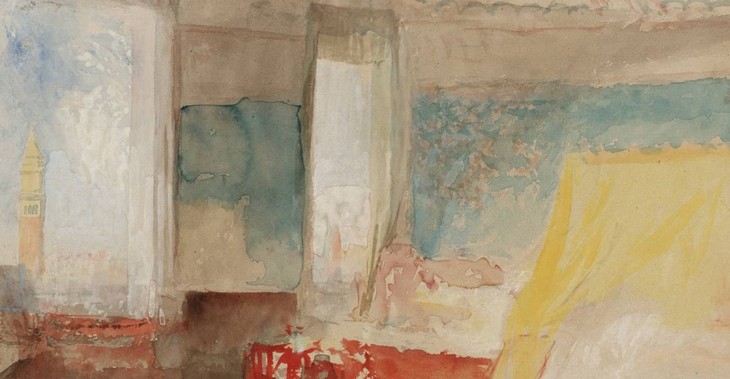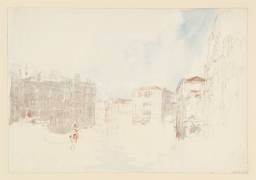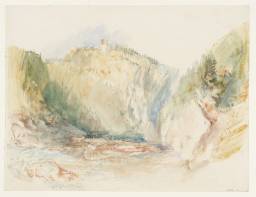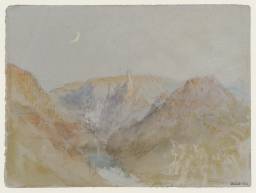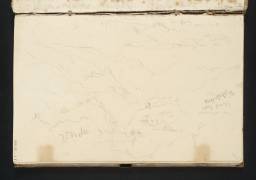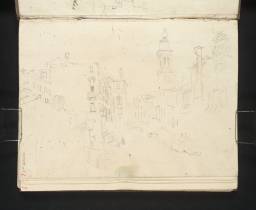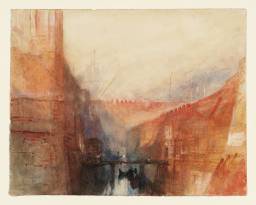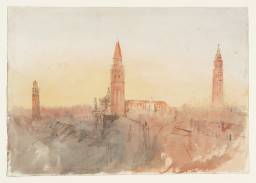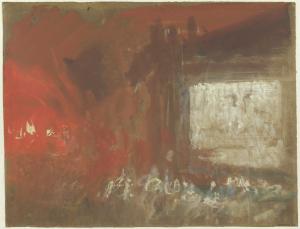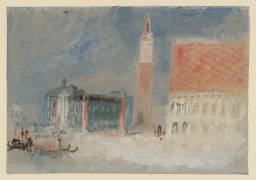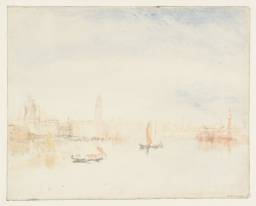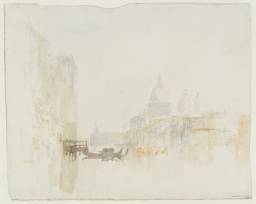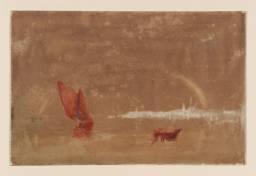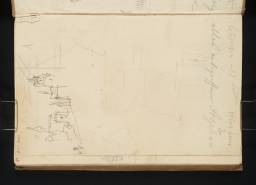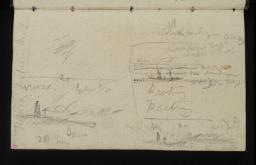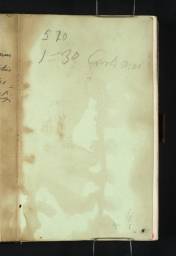From the entry
In August and September 1840, Turner’s customary late summer tour culminated with two weeks in Venice, on what was to be the longest and last of his three visits following those of 1819 and 1833, covered in earlier sections of this catalogue. The limpid, luminous watercolours associated with this final stay, in the Turner Bequest and elsewhere, are amongst his most renowned, discussed, reproduced, exhibited and appreciated works. John Ruskin, Turner’s greatest advocate in the artist’s later years (his own deep connection with the city being epitomised in his three-volume Stones of Venice of 1851–3), declared of the Turner Bequest examples display at the National Gallery: ‘Characteristic of Turner’s entirely final manner when the languor of age made him careless, or sometimes reluctant in outline, while yet his hand had lost none of its subtlety, nor his eye of its sense for colour.’ The artist’s biographer A.J. Finberg observed in 1930 that most ...
Rotterdam to Venice Sketchbook 1840
D32263–D32299, D32301–D32441, D32443, D41025, D41027–D41032
Turner Bequest CCCXX 1–92
D32263–D32299, D32301–D32441, D32443, D41025, D41027–D41032
Turner Bequest CCCXX 1–92
Grand Canal and Giudecca Sketchbook 1840
D32117–D32137, D32178, D41533–D41534
Turner Bequest CCCXV 1–21, CCCXVI 41
D32117–D32137, D32178, D41533–D41534
Turner Bequest CCCXV 1–21, CCCXVI 41
Venice; Passau to Würzburg Sketchbook 1840
D31277–D31312, D31314, D31316–D31415, D41399–D41402
Turner Bequest CCCX 1–70a
D31277–D31312, D31314, D31316–D31415, D41399–D41402
Turner Bequest CCCX 1–70a
Würzburg, Rhine and Ostend Sketchbook 1840
D30460–D30488, D30490, D30492–D30538, D30540–D30596, D30598–D30632, D41128–D41130
Turner Bequest CCCIII 1–89
D30460–D30488, D30490, D30492–D30538, D30540–D30596, D30598–D30632, D41128–D41130
Turner Bequest CCCIII 1–89
Separate sheets from the outward journey: the Rivers Mosel and Rhine; Landeck; Bolzano (Bozen)
D28949–D28950, D28955, D28957, D28963, D28966–D28967, D28974, D28979, D28987–D28988, D28992, D28998–D29000, D29020, D32189, D33899–D33914, D36079, D36085, D36152, D36154–D36156, D36168, D36173, D40177, D40178, D40188, D40319, D41474, D41476, D41477
Turner Bequest CCXCII 2, 3, 3v, 8, 10, 16, 19, 20, 27, 27v, 32, 40, 41, 45, 45v, 50, 50v, 51, 69, CCCXVII 10, CCCXLI 194–209, CCCLXIV 233, 239, 295, 297–299, 310, 315
D28949–D28950, D28955, D28957, D28963, D28966–D28967, D28974, D28979, D28987–D28988, D28992, D28998–D29000, D29020, D32189, D33899–D33914, D36079, D36085, D36152, D36154–D36156, D36168, D36173, D40177, D40178, D40188, D40319, D41474, D41476, D41477
Turner Bequest CCXCII 2, 3, 3v, 8, 10, 16, 19, 20, 27, 27v, 32, 40, 41, 45, 45v, 50, 50v, 51, 69, CCCXVII 10, CCCXLI 194–209, CCCLXIV 233, 239, 295, 297–299, 310, 315
Venice
D32138–D32143, D32145–D32177, D32179–D32181, D32183–D32184, D32191–D32217, D32219–D32220, D32222–D32258, D33883–D33884, D34231–D34233, D34864–D34865, D35882, D35949, D35980, D36089, D36190, D36192, D36259, D40157–D40159, D40176, D40182, D40321–D40322, T08220
Turner Bequest CCCXVI 1–6, 8–40, 42, CCCXVII 1–2, 4–5, 12, 13a–d, 14a–d, 15–32, 34, CCCXVIII 1, 3–29, CCCXIX 1–10, CCCXLI 183, 183v, CCCXLII 40–41, 41v, CCCXLIV 374, 374v, CCCLXIV 43, 106, 137, 243, 332, 334, 392
D32138–D32143, D32145–D32177, D32179–D32181, D32183–D32184, D32191–D32217, D32219–D32220, D32222–D32258, D33883–D33884, D34231–D34233, D34864–D34865, D35882, D35949, D35980, D36089, D36190, D36192, D36259, D40157–D40159, D40176, D40182, D40321–D40322, T08220
Turner Bequest CCCXVI 1–6, 8–40, 42, CCCXVII 1–2, 4–5, 12, 13a–d, 14a–d, 15–32, 34, CCCXVIII 1, 3–29, CCCXIX 1–10, CCCXLI 183, 183v, CCCXLII 40–41, 41v, CCCXLIV 374, 374v, CCCLXIV 43, 106, 137, 243, 332, 334, 392
The return journey: Passau; Regensburg and the Walhalla; Coburg and Schloss Rosenau; Würzburg
D24776, D25101, D28960, D28971, D28993, D28997, D29006, D29011–D29012, D32185–D32188, D32190, D33871, D34081, D34084–D34085, D34093, D34515, D34516, D35889, D35948, D36150–D36151, D36153, D36157–D36158, D36162, D36174, D36187
Turner Bequest CCLIX 211, CCLXII 1, CCXCII 13, 24, 46, 49, 57, 60–61, CCCXVII 6–9, 11, CCCXLI 174, 360, 363–364, 371, CCCXLIV 151, 152, CCCLXIV 49, 105, 293–294, 296, 300–301, 305, 316, 329
D24776, D25101, D28960, D28971, D28993, D28997, D29006, D29011–D29012, D32185–D32188, D32190, D33871, D34081, D34084–D34085, D34093, D34515, D34516, D35889, D35948, D36150–D36151, D36153, D36157–D36158, D36162, D36174, D36187
Turner Bequest CCLIX 211, CCLXII 1, CCXCII 13, 24, 46, 49, 57, 60–61, CCCXVII 6–9, 11, CCCXLI 174, 360, 363–364, 371, CCCXLIV 151, 152, CCCLXIV 49, 105, 293–294, 296, 300–301, 305, 316, 329
References
In August and September 1840, Turner’s customary late summer tour culminated with two weeks in Venice, on what was to be the longest and last of his three visits following those of 1819 and 1833, covered in earlier sections of this catalogue. The limpid, luminous watercolours associated with this final stay, in the Turner Bequest and elsewhere, are amongst his most renowned, discussed, reproduced, exhibited and appreciated works. John Ruskin, Turner’s greatest advocate in the artist’s later years (his own deep connection with the city being epitomised in his three-volume Stones of Venice of 1851–3), declared of the Turner Bequest examples display at the National Gallery: ‘Characteristic of Turner’s entirely final manner when the languor of age made him careless, or sometimes reluctant in outline, while yet his hand had lost none of its subtlety, nor his eye of its sense for colour.’1
The artist’s biographer A.J. Finberg observed in 1930 that most such watercolours ‘seem to have been done for Turner’s own pleasure, as they are generally carried only as far as he chose to carry them, without reference to other people’s ideas of finish or completion.’2 He considered the appeal of Turner’s Venice to viewers by then accustomed to various modes of Modernism:
I believe this series, especially the water-colours, is more generally liked and admired ... than any other group of his works. ... There is something ... which appeals with particular force to the artist, to the art-critic, and to the art-loving public of to-day. The attraction may be in the subject-matter; but I think it is also in the way Turner treats it, for he so often succeeds in doing what the modern artist seems to want to do but fails in.3
Finberg had previously considered the reasons:
The scenes float before us in all the bareness of immediate sensation. They give us nothing more than a moment of immediate experience caught, as it were, on the wing, and pinned down all quivering with life. But the momentary experience is that of a man whose visual sensations have been organised by a life-time of strenuous intellectual control.4
Since Ruskin’s time a vast literature has accrued, and the artist’s extensive Venetian work, both on paper and in oils over some three decades, has been the subject of monographic studies by Turner scholars Finberg (1930), Lindsay Stainton (1985), Andrew Wilton (1995) and Ian Warrell (2003, with complementary essays by Jan Morris, Cecilia Powell and David Laven and technical advice from paper conservator Peter Bower); the latter on the occasion of a major exhibition touring internationally from Tate Britain, with the Turner Bequest watercolours featuring prominently. Hardy George’s 1971 ‘Turner in Venice’ article had included some important documentary findings relative to Turner’s movements and dating issues, complemented by Cecilia Powell’s detailed work on the wider tour as a background to the Venice stay (Turner in Germany, 1995).5
There was a great deal more to see on the long European journeys to and from the city, some familiar but much that was new: along the Mosel and down the Rhine, through Austria and its territories in northern Italy (including Venice itself) and Slovenia, and around southern Germany. Turner was now sixty-five, and this wide-ranging and innovative itinerary constituted what proved to be the last of many such exploratory Continental tours since 1817 (preceded by the necessarily isolated visit to the Alps and Paris in 1802). James Hamilton has characterised the varied subject matter and treatment of the 1840 watercolours as ‘celebrations of a vivacious, energetic and joyful old age’, suggesting that the ‘late-flowering experience recharged his creativity’.6 Between 1841 and 1844, summer travels focused on the Swiss Alps, and as the artist’s health and energy began to flag, two brief trips to northern France brought foreign excursions to an end in 1845.
Although it had long been known from Turner’s own correspondence and contemporary sources that he had visited Venice in 1840, his route and which particular sketchbooks and watercolours should be associated with it were the subject of debate for many years. In the context of others through Germany in the 1830s and 1840s, the framework of this tour was definitively established by Powell,7 and summarised in her ‘Approaches to Venice’ essay in 2003’s Turner and Venice.8 With minor refinements, the outline which follows is indebted to these sources.
The outward journey:
As set out in full in the technical notes below, Turner set off with a handful of his customary card-covered ‘roll’ sketchbooks, a stock of his favoured grey paper, and various white sheets; he also tried out local supplies as he went. The overall tour is embodied in the interconnected subject matter of the artist’s customary pencil sketches in five locally sourced hardback pocket books (all Tate; Turner Bequest), used almost continuously on his round trip from the North Sea to the Adriatic. The phases of the itinerary are set out in detail through these books’ Introductions. For favoured subjects, they were supplemented by many separate colour studies, generally over pencil outlines done on the spot, and a few which remained in pencil alone. All of the separate sheets associated with the outward and return journeys are grouped in two subsections of the present catalogue.
The Rotterdam to Venice sketchbook (Turner Bequest CCCXX) was evidently acquired upon landing at the Dutch port, and served the artist through often mountainous Alpine terrain across Europe, with room left for dozens of drawings in Venice itself. First-hand evidence of the early stages comes in a letter of 24 August 1840, sent from Rome to ‘J.M.W. Turner Esqre., Post Office, Venice’. Apparently signed only ‘E.H.’ (the original is untraced), it shows that a husband and wife had initially accompanied the artist:
My dear Turner,
My better half would have written to you herself but since she has been here, unfortunately her health has not been very good and I have therefore taken up the Pen for her. We hope this letter will find you quite well at Venice, after you left us at Bregentz we soon found ourselves among the mountains, ... we may have the pleasure of seeing you on our way back, as you said you would return in 2 months which is our time. Will you write to us two Lines at Basle, if you write soon; or at Liege. ... How sincerely I hope you are quite well and please with your route ...9
Turner had (unusually) obtained a passport on 14 July, attended a Royal Academy meeting on 28 July and wrote a letter from his London house the next day; he presumably travelled out on 1 or 2 August by one of the weekend steamers to Holland.10 Powell found that Mr and Mrs Henry Harpur’s passports had been registered immediately before the artist’s, which likely accounts for his bothering to arrange one himself this time: ‘it is tempting to suggest that Turner set out in the company of his cousin (and solicitor) Henry Harpur and his wife Eleanor’;11 perhaps the latter dictated or approved the letter and initialled it. Turner preferred to travel alone as a rule – the tours of 1802 and 1836 being other notable exceptions – but this scenario seems highly likely.12
There are no drawings in the Rotterdam to Venice book after Rotterdam itself until Heidelberg in Germany to the south-east; Turner had taken to using sheets of grey paper on a brief detour up the Mosel from Coblenz, a year on from his most recent visit, which had resulted in colour studies on blue (mostly Tate; Turner Bequest; see Alice Rylance-Watson’s ‘The Second Meuse-Moselle Tour 1839’ section of this catalogue). This time he produced a complementary batch of watercolour and gouache studies, and continued using a folded piece of the same paper for pencil sketches at Bonn and familiar subjects up a short stretch of the Rhine beyond.
From Heidelberg, presumably by way of Stuttgart, the little party reached Bregenz, beside Lake Constance (the Bodensee) at the western tip of Austria, where Turner made a few colour studies13 on Dutch or German papers (see the technical notes below) dispersed to other collections after he ‘perhaps ... gave or sold them to his companions’.14 Finberg inferred they were there ‘on the 10th or 11th of August’;15 echoing Finberg’s outline of Turner’s solo onward journey, ‘bound for Venice, viâ Innsbruck and Landeck’,16 Powell summarised the rest of the route: ‘From there he made briskly for Innsbruck, crossed the Alps over the Brenner Pass, revisited Bolzano (buying three further sketchbooks) and travelled along tortuous mountain roads and valleys through the Dolomites to Belluno.’17
Rather than making for the Brenner (which he had used in 1833),18 newly identified Rotterdam to Venice sketches show that Turner headed south from Landeck (of which there are colour studies on white sheets) through the Passo di Resia (Reschenpass) from the Austrian Tyrol into South Tyrol (Alto Adige or Südtirol) in what is now northern Italy, before turning east to Merano (Meran) and Bolzano (Bozen), where he made colour studies of the city and nearby castles on grey paper. Between there and Belluno he paused long enough at Pieve di Cadore to sketch the birthplace of one of his lasting influences, the great Venetian painter Titian.
Venice:
As Hardy George established from entries in the Gazzetta Privilegiata di Venezia, Turner reached Venice on Thursday 20 August, and left on Thursday 3 September.19 As he seems to have done in 1833, he stayed in style at the Hotel Europa (Palazzo Giustinian), in a spectacular position fronting the Bacino entrance to the Grand Canal, looking south to the Dogana and Santa Maria della Salute opposite. His room was evidently high up at the back, affording panoramic views over the rooftops to the iconic campanile of San Marco (St Mark’s), with San Giorgio Maggiore also in sight across the Bacino; both are glimpsed through the open windows of a colour study which he proudly inscribed ‘J M W T Bedroom at Venice’ (D32219; CCCXVII 34).
There is no day-to-day record of his activities except as embodied in the sketchbooks and colour studies. The much younger watercolourist William Callow (1812–1908), also staying at the Europa, recalled that while ‘enjoying a cigar in a gondola I saw Turner in another one sketching San Giorgio, brilliantly lit up by the setting sun. I felt quite ashamed of myself idling away my time whilst he was hard at work so late.’20 In terms of pencil sketches, the Rotterdam to Venice book was likely filled up first; next he probably started afresh with the Venice and Botzen sketchbook (Turner Bequest CCCXIII) before rounding off at one end of the similar Venice; Passau to Würzburg book (Turner Bequest CCCX). Both comprise paper watermarked ‘J. Whatman’, an Austrian imitation of the well-known English brand; as Powell suggested (see above), were likely bought at Bolzano with a third saved for later.
Twenty-two disbound landscape-format leaves of genuine English ‘J Whatman | 1834’ paper comprise (including one addition) what Finberg called the ‘Roll Sketch Book of Venice’.21 Turner’s approach in this relatively small sequence of individual works is notably varied and virtuosic: some left at an early stage, others effectively finished; some over pencil outlines, some in watercolour alone; some with sharp shadows suggesting direct observation at specific times in broad daylight, others with strong sunset or mysterious twilit and moonlit effects. As Warrell has observed: ‘Whether he applied the watercolour in studies such as this actually on the spot or sometime later, back in his hotel room, is a matter of continuing debate. ... From at least 1836, however, ... it is clear that Turner began to paint more regularly in watercolour during his travels.’22 The pages are unified to some extent by their subject matter, and in 2003 Warrell presented them as a ‘Grand Canal and Giudecca’ sketchbook (the title retained here), giving a sense of a ‘journey through the centre of Venice, and then away to its unfamiliar western edges’.23
As listed and described in the Grand Canal and Giudecca’s Introduction, there are nineteen Venice watercolours in other collections on matching separated leaves; ten further dispersed subjects on miscellaneous white, grey and buff papers are also set out there.24 It has variously been suggested that the uniform leaves were once part of the same sketchbook, or one or more much like it, and that some at least had been sold through Turner’s agent in later years, Thomas Griffith, in the absence of formal commissions for new Venice watercolours;25 some were owned by Ruskin. Six show increasingly dramatic storm effects, culminating in the startling Lightning in the Piazzetta (National Gallery of Scotland, Edinburgh),26 while others exhibit a range of calmer effects and subjects comparable with those still in the Bequest, albeit generally worked up towards a greater degree of conventional ‘finish’. Since ‘few of Turner’s late roll sketchbooks contained more than twenty-four sheets’,27 Warrell proposed that just two books of the 1834 Whatman paper were carried from London, and named the dispersed leaves the ‘Storm’ sketchbook,28 albeit subsequently noting that this was for the sake of a ‘simple distinction’, and in working practice the pages ‘would have been intermixed’.29
At any event, the dramatic weather was evidently not imaginary, as Warrell has observed: ‘It is apparent that in 1833, and again in 1840, Turner was subjected to the scirocco winds, which bring sudden and sustained inundations during the long summer days in Venice’ with sketchbook drawings (D31908, D31910; CCCXIII 60, 61) ‘quite specific in documenting the unexpected arrival of lowering clouds and driving rain’30 (see also D33883; CCCXLI 183). Hamilton suggested ‘it is worth noting that the only Venice he ever saw was late summer Venice with its long days, its storms, mists, and its particular light.’31 As well as evoking full daylight, dawn and sunset effects, there are numerous night studies, for which the warm brown Italian papers Turner had acquired were particularly suited. Hamilton has pictured him as ‘a nocturnal animal. There are watercolours of St Mark’s Square ... at night, there are fireworks, lightning storms, theatrical performances, prostitutes greeting clients, firelight and long dark journeys up side canals.’32 Paul Spencer-Longhurst has described Venice as a Byronic ‘centre of Romantic moonlight’: ‘It is hard to realise how innovative Turner’s moonlit views of the city were in their own day. ... the poetic sensibility of the time yearned for the more magical city revealed after dark in place of the dilapidated palaces and canals choked with weeds.’33
Stainton made informal visual groupings of Turner Bequest and other watercolours in the plates and commentaries of Turner’s Venice,34 while Warrell’s more comprehensive arrangement of the core ‘Locating Turner’s Venice’ section of Turner and Venice reflects particular aspects of the artist’s interest such as ‘Monumental Venice’, ‘Venice after Dark’ and ‘The Giudecca Canal’.35 In a similar spirit, the separate works in the present catalogue are presented in parallel subsections as follows, with night scenes scattered among them:
in and around the Hotel Europa; St Mark’s Square, the Piazzetta and the Molo; the Grand Canal; down the side canals; the Bacino, Canale della Giudecca and Canale di San Marco; the Lagoon (including Tate T08220, the only non-Bequest item); interiors and figure scenes
There is also a group of six technically similar ‘Grand Canal, Bacino and Giudecca Views, some perhaps related to paintings’ in watercolour on grey paper, where the dating is less secure; 1833 has been proposed as an alternative, as discussed in the subsection’s Introduction. The complex issues around dating the Venice sheets (and indeed until comparatively recently the dates and routes of the very tours themselves)36 have gradually been distilled to the point where the solution embodied in Warrell’s 2003 text, placing virtually all the separate works within and beyond the Turner Bequest at 1840,37 has been generally accepted.38
Dating the views of the campanile of St Mark’s as presented in the sketchbooks and elsewhere has been facilitated by historical evidence. Tiers of scaffolding around its spire are seen in many drawings (most clearly of all in D32204; CCCXVII 19, on grey paper), and indicated systematically by Finberg and the curator and Turner scholar C.F. Bell (1871–1966) in their annotated copies of the 1909 Inventory.39 As Hardy George reported, Bell also mentioned the same feature of the Venice and Botzen drawings and the separate sketches catalogued here in his undated annotations to Finberg’s 1930 book40 (where Venice and Botzen was dated 1840).41 At that stage Bell linked them with the spurious 1835 visit proposed by Finberg (see below), but as George went on: ‘it is unlikely that the scaffolding put up in 1830 was still there in 1832–35. The following Campanile restoration dates were passed on to me by Dr. Giorgio E. Ferrari, Director of the Biblioteca Nazionale Marciana: 1819–21, 1822, 1824, 1830 and 1840.’42 He concluded:
[Bell’s] interesting grouping of the sketches and sketchbooks showing the Campanile with and without scaffolding seems to work when applied to the tours of 1833 (without) and 1840 (with). This also helps date some of the water-color sketches which are difficult to date stylistically and have been placed in a general period between 1835 and 1840.43
Stainton specified that the scaffolding was in place ‘from November 1838 to 22 December 1840’.44 D32204, as mentioned above, may be connected to a pencil drawing (D32435; CCCXX 88) in the Rotterdam to Venice sketchbook, dated to 1840 by Finberg.45 As Wilton observed, the same book includes a slight sketch (D32441; Turner Bequest CCCXX 91) which relates to a much elaborated colour study on grey paper showing the church of Santo Stefano (D32217; CCCXVII 32),46 while there is a similar link between one in the Venice and Botzen book (D31903; Turner Bequest CCCXIII 57a) and a grey-paper study of the Rio di San Luca (D32214; CCCXVII 29).47 Such connections led Wilton to propose dating all the ‘late Venice drawings’ including those on brown and grey to ‘1840 or immediately afterwards’, albeit he felt that ‘such a simple grouping is wholly unsupported by evidence and the problem must remain unresolved.’48 He further characterised the issue:
It is by no means certain that Turner had made all the Venetian sequence before he embarked for Switzerland in August 1841: many of them may have been reminiscences rather than direct records, and the series as a whole has the air of a developing fantasy on Venetian themes which could as well have been evolved in England as in Italy. Even so, there are several drawings that clearly record particular moments; and in looking at the whole series we receive a strong impression of their having been done together, or at least within a relatively short time.49
Finberg had proposed an 1835 visit50 partly in terms of the rooftop views from the Europa, now associated with the artist’s 1840 stay, as supposedly informing the 1836 oil painting Juliet and her Nurse (private collection; engraved in 1842 as ‘St Mark’s Place, Venice’: Tate impression T05188).51 The composition shows a view eastwards to the campanile from high above the Piazza San Marco (St Mark’s Square), with fireworks in the distance; compare in particular D32229 (CCCXVIII 10).52 This interdependence was questioned by Wilton, there being ‘in fact no precise connection’.53 As Ian Warrell has noted, while such a supposition had ‘the advantage of these compositional elements’, the dating of any such colour studies on brown paper to Turner’s 1833 visit54 has been ‘crucially undermined’ by Powell’s technical link with a German subject unique to 1840, ‘evidently made on the same sheets’.55
Specifically, Powell noted: ‘One of the torn edges of TB CCXCII 60 [D29011] makes a perfect fit with TB CCCXIX 1 [D32249], depicting the Salute’56 in Venice. The first work is one of three on brown sheets showing the ruins of Burg Hals, near Passau, which Turner only visited as he returned home in 1840. Powell also confirmed the close technical similarities between the grey Bally, Ellen and Steart sheets used for colour studies before, at and after Venice.57
The return journey:
However much remained to be completed, after two very full weeks Turner left Venice for what proved to be the last time on 3 September, and crossed the gulf to Trieste. All the while using the Trieste, Graz and Danube sketchbook (Turner Bequest CCXCIX, the last of the ‘J. Whatman’ trio), he traversed rugged modern Slovenia, pausing at Ljubljana, and passing into Austria again via Graz on the way to Vienna, which he reached on 7 September.58 He took a steamer up the scenic Danube (familiar from a trip in the other direction in 1833) and into southern Germany, which he was nearing on 10 September (inferred from his notes on D30074 and D30075; CCXCIX 39, 39a). At Passau, the first of a string of German cities and towns, he took up the quarter-full Venice; Passau to Würzburg book again. The brief stay at Passau, at the confluence with the Inn, proved stimulating, and he used the last of his English ‘roll’ sketchbooks, Passau and Burg Hals (Turner Bequest CCCXL), for larger pencil and watercolour studies of the city and its surroundings, as well coloured papers as already mentioned.
Turner was at Regensburg by Monday 14 September59 if not at the weekend, using the sketchbook and grey paper for views of the city in its Danube setting and venturing a few miles downstream to survey the imposing, temple-like Walhalla monument, nearing completion at Donaustauf. 16–17 September saw him at Bamberg,60 having passed through Nuremberg; seemingly he immediately travelled the short distance north to Coburg, in order to visit nearby Schloss Rosenau, the family home of Prince Albert (married that year to Britain’s Queen Victoria). He was still at the town on Sunday 20 September;61 three days later he was at Würzburg,62 where he made extensive use of the Würzburg, Rhine and Ostend sketchbook, probably bought locally. He used it again upon rejoining the Rhine around Mainz, rapidly sketching the castles and towns all the way downstream back to Bonn and Cologne. From there he struck west into Belgium, likely making use of the country’s burgeoning railway network, pausing briefly at Mechelen (Malines), north of Brussels. Before reaching the coast he sent an urgent business letter ahead, which ‘a gentleman travelling faster’ kindly posted for him in Dover on 27 September.63
At last, he got to Ostend, inevitably drawing around the harbour and beach for a while before steaming for England. Even when nearing home, he continued sketching, with quick views of Dover and Deal in Kent rounding off the Würzburg, Rhine and Ostend book. Perhaps first pausing briefly to relax at Margate, he was back in London on Wednesday 7 October, after nearly ten indefatigable weeks away,64 as shown in his letter of that date: ‘I should have answered sooner, but have only arrived from Venice a few hours’.65
Related works:
Discussing the artist’s many Venetian oil paintings, James Hamilton has observed:
Venice was becoming as popular a subject for art connoisseurs in the 1830s and 1840s as it was a destination for tourists. Responding as Turner did to the art market, Venice came more prominently into his repertoire because these were subjects which he knew would fetch buoyant prices.66
He had exhibited his first two Venice paintings at the Royal Academy shortly before his visit of 1833, and in the years before the present tour a further six, including two in 1840 itself.67 While many of the pencil sketches from the present tour doubtless informed aspects of the seventeen which followed between 1841 and 1846, as suggested occasionally in the entries, there are few obvious connections to be made. Two exceptions are St Benedetto, looking towards Fusina of 1843 (Tate N00534)68 and Approach to Venice, shown the following year (National Gallery of Art, Washington, DC; engraved in 1859: Tate impression T05193),69 which have uncharacteristically close watercolour counterparts, D32129 (CCCXV 13) and D32153 (CCCXVI 16) respectively.
In terms of other subjects, in 1841 Turner showed a large oil painting of Schloss Rosenau, Seat of H.R.H. Prince Albert of Coburg, near Coburg, Germany at the Academy (Walker Art Gallery, Liverpool),70 but it failed to attract royal patronage. A visionary panorama of The Opening of the Wallhalla [sic], 1842 (Tate N00533)71 followed in 1843, but would remain on his hands after he sent it to an international exhibition in Munich in 1845. A marine view of Ostend, exhibited at the Academy in 1844 (Neue Pinakothek, Munich),72 perhaps recalled the end of this tour.
In terms of contemporary or subsequent works on paper in other collections, twenty-nine Venice watercolours of various descriptions have been noted above and are listed in full elsewhere in this catalogue.73 There are also various subjects from the outward and return journeys, many of which were traditionally mis-identified and consequently not associated with this tour. As already mentioned, there are four colour views of Bregenz on blue paper (private collection;74 Courtauld Gallery, London;75 National Gallery of Ireland, Dublin;76 Cooper Gallery, Barnsley77). A radiant watercolour of Passau, Germany, at the Confluence of the Rivers Inn and Danube is also in Dublin.78 Warrell has recently associated three Regensburg subjects (finished to varying degrees and linked to adjacent pages in the Venice; Passau to Würzburg book) with a Turner Bequest colour study of the Walhalla (D36174; CCCLXIV 316).79 They show the Thurn and Taxis Palace (private collection),80 a night-time view from Turner’s hotel with a dramatic fire (Whitworth Art Gallery, Manchester),81 and a glowing sunset over the Danube (Victoria and Albert Museum, London).82
Nearing the end of the itinerary, there are two variant watercolours of Würzburg (currently untraced;83 National Museum Wales, Cardiff84). A group of watercolours of around 1840, traditionally associated with Great Yarmouth (an equally exposed port on the Norfolk North Sea coast),85 have been confirmed or proposed as Ostend subjects by Warrell and others in recent years: Ostend Harbour (National Gallery of Ireland, Dublin),86 a scene with fishing nets cast up on a beach with a spire, lighthouse and windmill in the distance (Ashmolean Museum, Oxford, currently as ‘Yarmouth, Norfolk’),87 and the moonlit Steamer off Ostend (Lady Lever Art Gallery, Port Sunlight).88
Technical notes:
Finberg gathered most of the Venice watercolours, gouaches and drawings on separate sheets in five consecutive sections of his 1909 Turner Bequest Inventory.89 The first, CCCXV, a ‘Roll Sketch Book of Venice’, comprised twenty-one leaves which were ‘all distributed and unnumbered’;90 today the section retains its distinct identity, with the addition of a stray leaf (D32178; CCCXVI 41), as the Grand Canal and Giudecca sketchbook, discussed in the main text above.
Rather than by specific subject, Finberg’s other Venetian sections were simply ‘classified as far as possible according to the kind of paper they are executed on’:91 CCCXVI 1–42 (‘White paper, &c.’);92 CCCXVII 1–34 (‘Grey Paper’);93 CCCXVIII (‘Brown Paper: large’);94 and CCCXIX 1–11 (‘Brown Paper: small’).95 Of these, CCCXVI 7 (D32144) has proved to be much earlier, while CCCXVII 3 and 33, CCCXVIII 2, and CCCXIX 11 were duplications of other entries. CCCXVII 6–11 (D32185–D32190), recognised by Finberg as ‘not Venetian’ but included ‘as they seem to have been done at the same time’,96 remain associated with the tour; they show northern Italian and German subjects from the outward and return routes. Finberg transcribed two of John Ruskin’s typically terse official notes in relation to these groupings, the first printed immediately after the entry for CCCXVIII 25 (D32252), apparently with reference to the preceding sheets: ‘(These were contained in a parcel endorsed by Mr. Ruskin, – A.B. 34. P.O. – “Out of Schedule 52. Colour on brown. Bad.”)’97 The second was in relation to section CCCXIX: ‘Part of a packet endorsed by Mr. Ruskin – “B. 6. Thirty-seven subjects or memoranda on grey, late time – but quite valueless either from badness or incompletion.”’98 Eleven additional sheets have here been introduced from Finberg’s broader Inventory groupings.
The following notes complement Ian Warrell’s appendix listing ‘The papers used for Turner’s Venetian Watercolours’ in his 2003 Turner and Venice exhibition catalogue, compiled with the assistance of paper conservator Peter Bower99 and dividing the 1840 sheets into eleven categories. It is not repeated here verbatim, being quoted and fully cross-referenced in the individual entries. The sketchbooks Warrell listed are given below again in the context of the wider tour:
Rotterdam to Venice (Turner Bequest CCCXX).100 White wove paper; 92 leaves; 149 x 89 mm; watermark ‘J H & C’; made by Jan Honig and Co., De Wever mill, Koog an der Zaan, Netherlands; supplied by Koopmans, Rotterdam
Venice and Botzen (CCCXIII).101 Cream wove; 70 leaves; 173 x 123 mm; watermark ‘J. Whatman’; unidentified Austrian maker
Grand Canal and Giudecca sketchbook(CCCXV + CCCXVI 41).102 White wove; 22 leaves (disbound); 220 x 320 mm; watermark ‘J Whatman | 1834’; maker unidentified; supplied by Roberson (sic) and Miller, London
Trieste, Graz and Danube sketchbook (CCXCIX).103 Cream wove; 66 leaves; 198 x 127 mm; watermark ‘J. Whatman’; unidentified Austrian maker
Venice; Passau to Würzburg sketchbook (CCCX).104 Cream wove; 70 leaves; 198 x 126 mm; watermark ‘J. Whatman’; unidentified Austrian maker
Passau and Burg Hals sketchbook (CCCXL).105 White wove; 9 leaves (disbound); 212 x 276 mm; watermark ‘R Turner’; perhaps made by Richard Turner, Upper Tolvil Mill, Maidstone, Kent
Würzburg, Rhine and Ostend sketchbook (CCCIII).106 Flecked pale blue laid; 90 leaves; 170 x 104 mm; watermarked with Tree of Liberty and countermarked with indecipherable maker’s name; possibly made by Roedter or Gossler families at Neustadt an der Weinstrasse, Rhineland-Palatinate (Rheinland-Pfalz)
Separate sheets were used at times on the outward and return routes, as well as at Venice, and the works are presented in two corresponding subsections of the present catalogue. Most are on Turner’s customary pieces of grey wove paper, neatly torn along folds or a straight edge as eighths (about 190 x 280 mm) or sixteenths (about 140 x 190 mm) from Imperial sheets (about 760 x 560 mm) made by Bally, Ellen and Steart of De Montalt Mill, Bath in 1829.107 The artist may have acquired his large stock ‘after the firm wound up its business in 1832’.108
It has been possible to reconstitute a large number of such sheets across the Turner Bequest,109 and the juxtapositions can be particularly useful when Turner used the pieces in small batches. Most sections from each of three such sheets from 1840 have been linked in this way. The first, divided into sixteenths, was used for Rivers Mosel and Rhine subjects on the outward journey. Only one section of one half, used on the Mosel, has been confirmed as belonging to it (D28998–D28999; CCXCII 50, 50v),110 with the other comprising D33899–D33914 (CCCXLI 194–209), eight portions used for slight pencil sketches of Rhine subjects (each numbered on both sides). Finberg’s 1909 Inventory states that at that time they were still ‘part of one large sheet folded into small sections’,111 although they have since been separated. The piece numbered D33899/D33911 is watermarked ‘B E | 18’, while a second (D33903/D33907) bears the other half: ‘E & S | 829’.112
Fourteen other individual pieces of the same size were used for colour studies on the Mosel and at Ehrenbreitstein, opposite its confluence with the Rhine:113 D28949 (CCXCII 2; verso D40319); D28950 (CCXCII 3; verso D41477); D28955 (CCXCII 8); D28957 (CCXCII 10); D28963 (CCXCII 16); D28966–d28967 (CCXCII 19, 20); D28974 (CCXCII 27; verso D41474); D28979 (CCXCII 32); D28987–D28988 (CCXCII 40, 41); D28992 (CCXCII 45; verso D41476); D29000 (CCXCII 51); and D29020 (CCXCII 69).
At Bregenz, Turner used blue sheets of around 190 x 280 mm, possibly of Dutch or German origin according to Bower,114 for four watercolour and gouache views (private collection;115 Courtauld Gallery, London;116 National Gallery of Ireland, Dublin;117 Cooper Gallery, Barnsley118).119 Tonally similar to his English paper, they have also been described as ‘grey’ in the past,120 having largely lost their stronger colour through time and exposure. Nevertheless, they constitute a distinct batch, albeit used in conjunction with the Bally, Ellen and Steart sheets of the same format: there is a pencil sketch of Bregenz on the other side of one of the grey Bolzano sheets discussed below.
Turner had used blue papers by the same maker from the later 1820s onwards, including for subjects associated with his Mosel tour of 1839,121 but blue sheets are few and far between this following year. Tate D32216 (Turner Bequest CCCXVII 31), a Venice subject, is one; it was not described in Warrell’s near-comprehensive 2003 listing, albeit discussed in the main text as a ‘piece of [English] Bally, Ellen and Steart’s blue drawing-paper, that he had recently used for drawings of Bregenz’.122 D25101 and D36157 (CCLXII 1, CCCLXIV 300), Würzburg views from the return journey, are others; all are of the same format as the Bregenz sheets, and variants of grey-paper subjects, perhaps suggesting that the artist was exploring the mood and effect of different background colours.
Further on in Austria, Turner made pencil sketches at Landeck on four sheets of white paper; all were developed with colour washes. Three are a little over 240 x 300 mm (D36079, D36085, D36168; Turner Bequest CCCLXIV 233, 239, 310), and the last bears an older ‘J Whatman | 1816’ watermark than the Grand Canal and Giudecca book’s ‘1834’. The fourth (D36173; CCCLXIV 315), at 260 x 280 mm, is conspicuously squarer, its unusual format being characteristic of many 1836 Val d’Aosta subjects. Perhaps these assorted sheets happened to be hand in Turner’s London studio as he prepared for the tour. At Bolzano (Bozen) he brought out the grey Bally, Ellen and Steart paper again, using five sheets of the larger one-eighth Imperial format: D32189 (CCCXVII 10), D36152 (CCCLXIV 295), D36154 (CCCLXIV 297; verso: D40188); D36155 (CCCLXIV 298; verso: D40177, an earlier view of Bregenz, as mentioned above); and D36156 (CCCLXIV 299; verso: D40178).
Turner’s use of coloured and white sheets to supplement his sketchbooks followed a similar pattern as he returned from Venice. For views of Burg Hals, near Passau, he used brown Fabriano-type papers (D29011–D29012, D36162; CCXCII 60, 61, CCCLXIV 305). As discussed within the general narrative above, the crucial significance here lies in the discovery that one of ‘the torn edges of TB CCXCII 60 [D29011] makes a perfect fit with TB CCCXIX 1 [D32249], depicting the Salute’123 in Venice; he used the same papers for most of the other Venice subjects in Turner Bequest sections CCCXVIII and CCCXIX.124 He also used what are doubtless sixteenths of one or more grey Bally, Ellen and Steart sheets around Passau (D24776, D28960, D28971, D28993, D28997, D29006, D33871; CCLIX 211, CCXCII 13, 24, 46, 49, 57, CCCXLI 174).125
For an excursion around Regensburg, Turner used a folded Imperial sheet of 1829 Bally, Ellen and Steart for pencil sketches, likely only separated before colour was added to some.126 (The Rhine drawings noted above never reached that stage.) Seven of the eight sections (D32185, D34081, D34084–D34085, D34093, D36150, D36153; Turner Bequest CCCXVII 6, CCCXLI 360, 363, 364, 371, CCCLXIV 293, 296, with the eighth untraced) were temporarily reassembled for Bower’s 1999 Turner’s Later Papers exhibition, showing that their slightly irregular edges match exactly.127 Bower has noted Turner’s habit of tearing such sheets, sometimes in advance or sometimes after making a sequence of sketches, unfolding and refolding the intact sheet as necessary.128 D34085 and D36150 bear the two halves of the watermark. D36151 (CCCLXIV 294) is a related view in the same format.
Five further pieces of the same size (D32186–D32188, D32190, D36158; Turner Bequest CCCXVII 7–9, 11; CCCLXIV 301) have been identified by Powell as showing Coburg and Würzburg subjects,129 from the latter stages of the tour. Again, they are neatly torn eighths of Bally, Ellen and Steart paper, albeit none of these sections bears a watermark. Powell suggested that the other three eights had likely been used in Venice,130 although this link was not explored in the subsequent Turner and Venice checklist. D36158, the Würzburg view, is complemented by variants on blue paper (D25101, D36157; CCLXII 1, CCCLXIV 300), as described above. The artist also used two larger sheets of as yet unidentified off-white paper (approaching 250 x 340 mm) for more expansive pencil sketches of the city (D34515–D34516; CCCXLIV 151, 152).
Finally, there are the conventional white sheets used for a colour study of the Walhalla (D36174; CCCLXIV 316), and views of Coburg (D35948, D36187; CCCLXIV 105, 329) and nearby Schloss Rosenau (D35889; CCCLXIV 49). As discussed in their respective entries, all may postdate the actual tour a little.
The following separate Turner Bequest Venice sheets are inscribed by Turner and later curatorial hands, in pencil unless otherwise stated; * indicates Finberg’s 1909 Inventory as the source. D32236 was unavailable for inspection at time of writing:
| Tate | Turner Bequest | Turner (verso) | Other verso | Ruskin (blue ink on recto) |
| D32138 | CCCXVI 1 | ‘29’ | ‘1568’ | |
| D32139 | CCCXVI 2 | ‘16’ | ‘1561’ | |
| D32140 | CCCXVI 3 | ‘from my Bed Room | Venice’ | ‘35’ | ‘1548’ |
| D32141 | CCCXVI 4 | ‘26’ | ‘1569’ | |
| D32142 | CCCXVI 5 | ‘AB 148 | Pm’ | ||
| D32143 | CCCXVI 6 | ‘AB 148 | [...]’ | ||
| D32145 | CCCXVI 8 | ‘27’ | ||
| D32146 | CCCXVI 9 | ‘30’ | ||
| D32147 | CCCXVI 10 | ‘31’ | ‘1572’ | |
| D32149 | CCCXVI 12 | ‘1530’ | ||
| D32150 | CCCXVI 13 | ‘1558’ | ||
| D32151 | CCCXVI 14 | ‘1557’ | ||
| D32152 | CCCXVI 15 | ‘72’ (blue) | ||
| D32153 | CCCXVI 16 | ‘38’ | ||
| D32154 | CCCXVI 17 | ‘55’; ‘12’ | ||
| D32155 | CCCXVI 18 | ‘6 V’ | ‘9’ | |
| D32156 | CCCXVI 19 | ‘5 V’ | ‘53’; ‘7’ | |
| D32157 | CCCXVI 20 | ‘56’; ‘20’ | ||
| D32158 | CCCXVI 21 | ‘Beppo Club’ | ‘57’; ‘B’; ‘18’; ‘A’ | |
| D32159 | CCCXVI 22 | ‘58’; ‘19’ | ||
| D32160 | CCCXVI 23 | (closed mount) | ||
| D32161 | CCCXVI 24 | ‘60’; ‘25’ | ||
| D32162 | CCCXVI 25 | ‘[...]5[...]’ | ||
| D40157 | [CCCXVI 25 v] | poetry | ‘52’; ‘6’ | |
| D32163 | CCCXVI 26 | ‘24’ | ‘15[?2]8’ | |
| D40158 | [CCCXVI 27 v] | ‘7 V’ | ||
| D32165 | CCCXVI 28 | ‘34’; ‘17’; ‘28’ | ||
| D32166 | CCCXVI 29 | ‘(29)’; ‘18’; ‘37’ | ||
| D32167 | CCCXVI 30 | ‘21’; ‘19’ | ||
| D32168 | CCCXVI 31 | ‘22’ | ||
| D32169 | CCCXVI 32 | ‘1579’ | ||
| D32170 | CCCXVI 33 | ‘33’ | ‘1560’ | |
| D32171 | CCCXVI 34 | ‘3 V’ | ‘10’ | ‘1573’ |
| D32172 | CCCXVI 35 | ‘32’ | ‘1633’ | |
| D32173 | CCCXVI 36 | ‘14 V’; ‘This [?belongs] to the Beppo Club’ | ‘22’; ‘14’ | ‘1570’ |
| D32174 | CCCXVI 37 | ‘1559’ | ||
| D40176 | [CCCXVI 37v] | ‘Beppo’ notes | ‘[?9]’ | ‘1564’ |
| D32175 | CCCXVI 38 | ‘28’ | ‘1556’ | |
| D32176 | CCCXVI 39 | ‘15’ | ‘1553’ | |
| D32177 | CCCXVI 40 | ‘17’ | ‘1579’ | |
| D32179 | CCCXVI 42 | ‘from my Bed Room | V’ | ‘36’ | |
| D32180 | CCCXVII 1 | ‘15’ | ||
| D32181 | CCCXVII 2 | |||
| D32183 | CCCXVII 4 | ‘16’ | ||
| D32184 | CCCXVII 5 | ‘17’ | ||
| D32191 | CCCXVII 12 | ‘18’ | ||
| D32194 | CCCXVII 13c | ‘3 V’ | ||
| D32198 | CCCXVII 14c | ‘2 V’ | ||
| D32201 | CCCXVII 16 | ‘19’ | ||
| D32202 | CCCXVII 17 | (closed mount) | ||
| D32204 | CCCXVII 19 | ‘20’ | ||
| D32205 | CCCXVII 20 | ‘8 V’ (recto) | ‘21’ | |
| D32206 | CCCXVII 21 | ‘22’ | ||
| D32207 | CCCXVII 22 | ‘23’ | ||
| D32208 | CCCXVII 23 | ‘24’ | ||
| D32209 | CCCXVII 24 | ‘6 V’ (recto) | ‘25’ | |
| D32210 | CCCXVII 25 | ‘26’ | ||
| D32211 | CCCXVII 26 | ‘1590’ | ||
| D32212 | CCCXVII 27 | ‘28’ | ||
| D32213 | CCCXVII 28 | ‘29’ | ||
| D32214 | CCCXVII 29 | ‘30’ | ||
| D32216 | CCCXVII 31 | ‘32’ | ||
| D32217 | CCCXVII 32 | ‘7’ (ink ?by Turner) | ||
| D32219 | CCCXVII 34 | ‘[?C] | J M W T Bedroom at Venice’; ‘4’ (ink) | ‘34’ | |
| D32220 | CCCXVIII 1 | ‘7’ (ink) | ||
| D32222 | CCCXVIII 3 | ‘28’ (ink) | ‘36’ | |
| D32223 | CCCXVIII 4 | ‘1’ (ink) | ‘37’ | |
| D32224 | CCCXVIII 5 | ‘2’ (ink) | ‘88’ | |
| D32225 | CCCXVIII 6 | ‘3’ (ink) | ‘39’; ‘S’ | |
| D32226 | CCCXVIII 7 | ‘8’ (ink) | ‘40’; ‘S’ | |
| D32227 | CCCXVIII 8 | ‘10’ (ink) | ‘41’ | |
| D32228 | CCCXVIII 9 | ‘11’ (ink) | ‘42’ | |
| D32229 | CCCXVIII 10 | ‘12’ (ink) | ‘43’ | |
| D32230 | CCCXVIII 11 | ‘15’ (ink) | ‘44’ | |
| D32231 | CCCXVIII 12 | ‘16’ (ink) | ‘45’; ‘S | TRIM’ | |
| D32232 | CCCXVIII 13 | ‘17’ (ink) | ‘46’; ‘S’ | |
| D32233 | CCCXVIII 14 | ‘18’ (ink) | ‘47’ | |
| D32234 | CCCXVIII 15 | ‘19’ (ink) | ‘48’; ‘S’ | |
| D32235 | CCCXVIII 16 | ‘20’ (ink) | ‘49’; ‘S’ | |
| D32236 | CCCXVIII 17 | ‘21’ (ink) | ||
| D32237 | CCCXVIII 18 | ‘24’ (ink) | ‘51’; ‘Solid’ | |
| D32238 | CCCXVIII 19 | ‘25’ (ink) | ‘Solid’ | |
| D32239 | CCCXVIII 20 | ‘26’ (ink) | ‘53’ | |
| D32240 | CCCXVIII 21 | ‘27’ (ink) | ||
| D32241 | CCCXVIII 22 | ‘28’ (ink) | ‘55’ | |
| D32242 | CCCXVIII 23 | ‘29’ (ink) | ‘56’ | |
| D32243 | CCCXVIII 24 | ‘30’ (ink) | ‘57’; ‘Solid’ | |
| D32244 | CCCXVIII 25 | ‘31’ (ink) | ‘58’ | |
| D32245 | CCCXVIII 26 | (closed mount) | ||
| D32246 | CCCXVIII 27 | ‘14’ (ink) | ‘60’ | |
| D32247 | CCCXVIII 28 | ‘98’ | ||
| D32248 | CCCXVIII 29 | (laid down) | ‘62’ (on mount) | |
| D32251 | CCCXIX 3 | ‘1’ (ink*; closed mount) | ||
| D32252 | CCCXIX 4 | ‘2’ (ink*; closed mount) | ||
| D32253 | CCCXIX 5 | ‘3’ (ink) | ||
| D32254 | CCCXIX 6 | ‘[?1]’ and/or ‘5’ (ink; latter* but now obscured?) | ||
| D32255 | CCCXIX 7 | ‘6’ (ink*; obscured?) | ||
| D32256 | CCCXIX 8 | ‘8’ (ink*; obscured?) | ||
| D40322 | [CCCXIX 9 v] | ‘9’ (ink) | ||
| D32258 | CCCXIX 10 | ‘10’ (ink) | ||
| D33884 | CCCXLI 183v | ‘O | 233’ | ||
| D34231 | CCCXLII 40 | ‘O | 1[...]’ | ||
| D34232 | CCCXLII 41 | ‘O | 1[...]’ (recto) | ||
| D35882 | CCCLXIV 43 | ‘68’ | ||
| D35980 | CCCLXIV 137 | ‘15’ | ||
| D36190 | CCCLXIV 332 | ‘1543’ | ||
| D36192 | CCCLXIV 334 | ‘1476’ | ||
| D40182 | [CCCLXIV 334 v] | ?poetry | ||
| D36259 | CCCLXIV 392 | ‘23’ |
Any significance the incomplete sequence of ink numbers ‘1’ to ‘31’ (with gaps) on the brown-paper sheets may have had is unclear, some being used more than once.
As transcribed above, nine miscellaneous Turner Bequest sheets bear Turner’s pencil numbers with a ‘V’ suffix, presumably standing for ‘Venice’, although whether they were potentially intended as the basis of a formal grouping or series is not known;131 the highest number is ‘14’. Two contemporary works in private collections, San Giorgio Maggiore and the Zitelle from the Giudecca Canal132 and The Doge’s Palace from the Bacino133 carry similar inscriptions (respectively ‘7 V’ and ‘5 V’), again duplicating numbers noted above.
Similar annotations with an ‘L’ for Lake Lucerne are scattered across Swiss sheets from the early 1840s; see for example Tate D36026 and D36027 (Turner Bequest CCCLXIV 182, 183).134 Two Coburg watercolours associated with the present tour are likewise numbered with a ‘C’ suffix (Tate D35948, D36187; Turner Bequest CCCLXIV 105, 329).
Catalogue notes (1881) in E.T. Cook and Alexander Wedderburn eds., Library Edition: The Works of John Ruskin: Volume XIII: Turner: The Harbours of England; Catalogues and Notes, London 1904, p.108.
Among accounts and commentaries on the tour in wider contexts, often referred to in the individual entries, see also Finberg 1961, p.381, Wilton 1974, pp.154–7, Wilton 1975, pp.134–50, Wilton 1987, p.208, Lyles 1992, pp.23–4, 67–9, 81–3, Upstone 1993, pp.11–12, 34–9, Warrell 1995, pp.11, 95–116, Herrmann in Joll, Butlin and Herrmann 2001, pp.360–3, Cecilia Powell, ‘Austria’, ‘Danube’ and ‘Venetian Theatres’ in ibid., pp.17, 73, 358, Venning 2003, pp.252–4, Wilton 2005, pp.2–8, Wilton 2006, p.242, Hamilton 2009 pp.95, 101, Costello 2012, pp.175 – 8, Moorby 2014, pp.104–13, and Warrell 2014, pp.188, 120, 192.
Letter (since lost) as first transcribed in Finberg 1930, pp.119–21; summarised in Finberg 1909, II, p.1029 footnote; see also Finberg 1961, p.381; given again in full in Gage 1980, pp.178–9 letter 238.
See Wilton 2006, p.242, and Warrell 2014, p.188, superseding John Gage’s alternative suggestion in Gage 1980, p.178 note 3 (as followed in Hamilton 1997, p.287, but previously discounted in Powell 1995, p.81 note 10); for Henry Harpur, see James Hamilton, ‘Mother’s Family’ in Joll, Butlin and Herrmann 2001, p.193.
Frequently quoted, for example in Hamilton 1997, p.287, and Warrell 2003, p.197, from H.M. Cundall ed., William Callow: An Autobiography, London 1908, pp.66–7.
Paul Spencer-Longhurst, Moonrise over Europe: JC Dahl and Romantic Landscape, exhibition catalogue, Barber Institute of Fine Arts, Birmingham 2006, p.47.
See for example George 1984, p.10, or Joll 1992, p.7; also Luke Herrmann, Ruskin and Turner: A Study of Ruskin as a Collector of Turner, Based on his Gifts to the University of Oxford; Incorporating a Catalogue Raisonné of the Turner Drawings in the Ashmolean Museum, London 1968, p.83, and Malcolm Cormack, J.M.W. Turner, R.A. 1775–1851: A Catalogue of Drawings and Watercolours in the Fitzwilliam Museum, Cambridge, Cambridge 1975, pp.65–7.
See Stainton 2003, p.6, accepting the brown sheets as from 1840 but restating the case for some grey as from 1833; see also Warrell 2003, p.21.
George 1971, p.85 note 6, also citing ‘Gregorio (Rosolino) Gattinoni’s Il Campanile di San Marco in Venezia, Venice, 1912 [sic, for 1910], [pp.]46, 63, 77, 78’.
Stainton 1985, p.50, citing Gattinoni 1910; see also Wilton 1974, pp.155, 156–7, Lindsay Stainton in Stainton and Richard S. Schneiderman, J.M.W. Turner Watercolors from the British Museum, exhibition catalogue, Georgia Museum of Art, University of Georgia, Athens 1982, p.70, Ian Warrell and Diane Perkins, Turner & Architecture, exhibition catalogue, Tate Gallery, London 1988, p.19, Ian Warrell, J.M.W. Turner 1775–1851: Impressions de Gran Bretanya i el Continent Europeu / Impresiones de Gran Bretaña y el Continente Europeo, exhibition catalogue, Centre Cultural de la Fundació ”la Caixa”, Barcelona 1993, p.307, Ian Warrell, J.M.W. Turner 1775–1851: Aquarelles et Dessins du Legs Turner: Collection de la Tate Gallery, Londres / Watercolours and Drawings from the Turner Bequest: Collection from the Tate Gallery, London, exhibition catalogue, Palais des Beaux-Arts de Charleroi 1994, p.222, and Warrell 2003, p.123.
Wilton 1974, p.155; see also Wilton 1975, pp.134, 135, 136, Wilton 1979, p.462, and Andrew Wilton, Turner Abroad: France; Italy; Germany; Switzerland, London 1982, p.61 under no.86; Joll 1992, p.7, disputes the proposition.
Martin Butlin and Evelyn Joll, The Paintings of J.M.W. Turner, revised ed., New Haven and London 1984, pp.215–17 no.365, pl.369 (colour).
See checklist in Stainton 1985, p.76, cross-referenced to Butlin and Joll 1984; see also ‘Appendix A: Exhibited oil paintings’ in Finberg 1930, pp.155–8.
Ibid., pp.241–2 no.392, pl.396 (colour); see also disputed version (Yale Center for British Art, New Haven), p.279 no.442, pl.397, and Joll 2001, p.280.
Most are reproduced in Wilton 1979, pp.463–5 nos.1352–1374; see also ‘Appendix B: Water-colours of Venice in public and private collections’ in Finberg 1930, pp.159–62.
Not in Wilton 1979; published in Edward Yardley, ‘Picture Notes: A View of Old Bregenz’, Turner Studies, vol.2, no.2, Winter 1983, pp.54–5, as ‘A View of Old Bregenz’, reproduced.
Not in Wilton 1979; Warrell 2015, p.5 fig.4 (colour), as ‘The Thurn und Taxis Palace, with the Obermunster in the Distance, Regensburg’, c.1840.
Wilton 1979, p.474 no.1455, as ‘A conflagration, Lausanne’, reproduced; Warrell 2015, p.4 fig.2, as ‘Regensburg: the Neupfarrplatz at Night, with a Nearby Fire’, c.1840.
Wilton 1979, p.487 no.1555, as ‘Lyons’, pl.256; Warrell 2015, p.6 fig.5, as ‘Regensburg from the Danube, with the Cathedral and Stone Bridge, at Sunset, c.1840.
Finberg 1909, II, pp.1016–29; see also ‘[Appendix C:] Miscellaneous Venetian drawings of 1835 and 1840’ in Finberg 1930, pp.173–6.
See Selborne 2008, p.96, and Anne Hodge in Hodge and Niamh Mac Nally, The Works of J.M.W. Turner at the National Gallery of Ireland, Dublin 2012, p.94 note 2.
See Cecilia Powell, Turner’s Rivers of Europe: The Rhine, Meuse and Mosel, exhibition catalogue, Tate Gallery, London 1991, p.130, and Bower 1999, p.98.
See Warrell 2003, p.259 sections 9–11, Powell’s point being confirmed under the last: ‘Grey-brown paper produced by an unknown maker (possibly also a batch made at Fabriano)’.
How to cite
Matthew Imms, ‘Tour of Venice, Austria and Southern Germany 1840’, September 2018, in David Blayney Brown (ed.), J.M.W. Turner: Sketchbooks, Drawings and Watercolours, Tate Research Publication, December 2019, https://www

